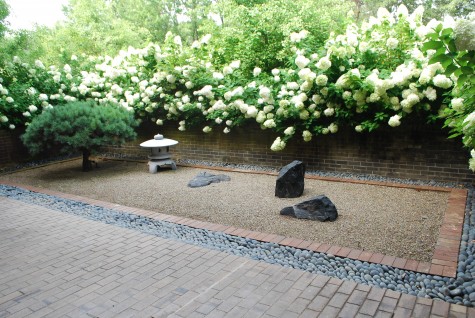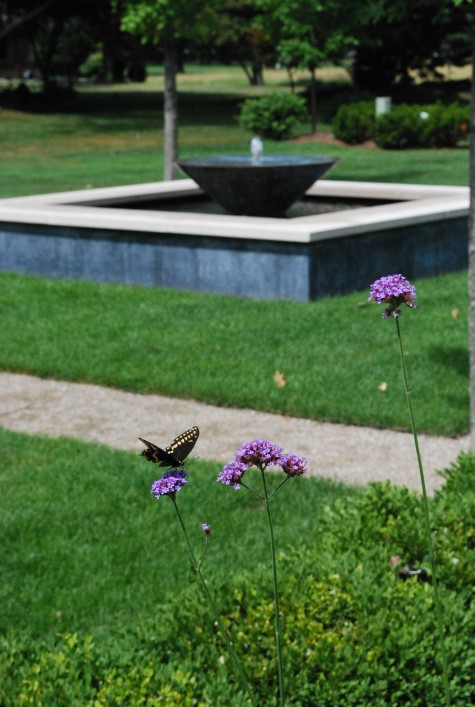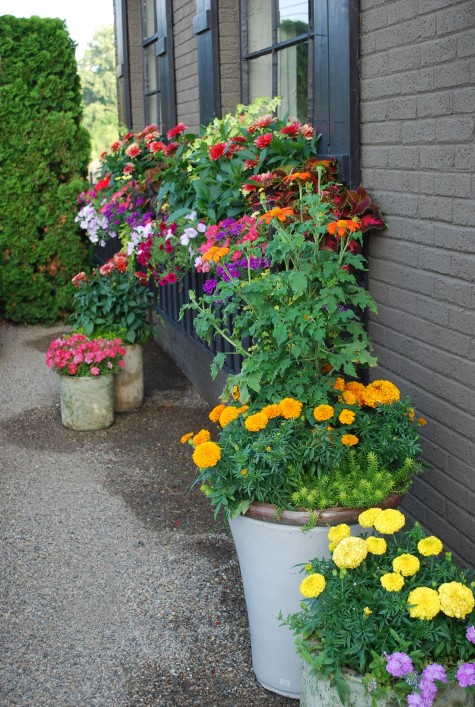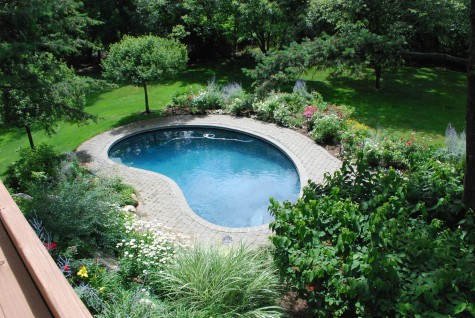 Usually I am a landscape and garden designer; this week I have been a prop delivering a steady stream of water at the shop, for clients, and at home. Proper watering in extremely high heat can be tricky. Annabelle hydrangeas, for example, wilt down at the the slightest provocation on a hot day. This makes sense. Their leaves are big, and very thin. This means water is evaporating from the leaves at a high rate-thus the wilt. This does not necessarily mean the Annabelles need water. Avoid hosing down plants, thinking you will cool them off. Fungus, and mildew can run wild in hot humid conditions. Unnecessary water can aid and abet diesease. Check the soil that your Annabelles are growing in-water if that soil is dry. Ironically, I have seen more plants suffering from too much water in this heat, than too little. The New Guinea impatiens pictured above-water like crazy. If they lack for water when the buds are small, those buds can drop, sending an entire plant out of bloom until new ones form. I had this happen at home-Fiona Brinks from Bordines set me straight about it.
Usually I am a landscape and garden designer; this week I have been a prop delivering a steady stream of water at the shop, for clients, and at home. Proper watering in extremely high heat can be tricky. Annabelle hydrangeas, for example, wilt down at the the slightest provocation on a hot day. This makes sense. Their leaves are big, and very thin. This means water is evaporating from the leaves at a high rate-thus the wilt. This does not necessarily mean the Annabelles need water. Avoid hosing down plants, thinking you will cool them off. Fungus, and mildew can run wild in hot humid conditions. Unnecessary water can aid and abet diesease. Check the soil that your Annabelles are growing in-water if that soil is dry. Ironically, I have seen more plants suffering from too much water in this heat, than too little. The New Guinea impatiens pictured above-water like crazy. If they lack for water when the buds are small, those buds can drop, sending an entire plant out of bloom until new ones form. I had this happen at home-Fiona Brinks from Bordines set me straight about it.
 Many annual plants have tropical origins. They thrive in the heat. Annual vinca will barely perform in Michigan-it needs heat Florida style to really perform well. Though I am dropping over from the heat, many of the annual plants are thriving, provided they are properly watered. This pot of coleus and lime irisine benefits from some shade at the hottest part of the day, and the petunias tolerate this condition. All of these plants are shrugging off the heat.
Many annual plants have tropical origins. They thrive in the heat. Annual vinca will barely perform in Michigan-it needs heat Florida style to really perform well. Though I am dropping over from the heat, many of the annual plants are thriving, provided they are properly watered. This pot of coleus and lime irisine benefits from some shade at the hottest part of the day, and the petunias tolerate this condition. All of these plants are shrugging off the heat.
 These pots look pretty sassy, in spite of the 96 degree weather we have today. The New Zealand flax is quite tolerant of heat, sun, and shade. The dracaena Janet Craig will burn in the sun, but it is very tolerant of heat. The Solenia begonias have no problem in sun, provided the watering is dead on. Too much water, and those succulent stems will rot. Too little, and they will flop over. Siting plants in conditions they like means your heat management will go better.
These pots look pretty sassy, in spite of the 96 degree weather we have today. The New Zealand flax is quite tolerant of heat, sun, and shade. The dracaena Janet Craig will burn in the sun, but it is very tolerant of heat. The Solenia begonias have no problem in sun, provided the watering is dead on. Too much water, and those succulent stems will rot. Too little, and they will flop over. Siting plants in conditions they like means your heat management will go better.
 Thick foliaged and waxy leaved plants transpire less than thin leaved plants. When a farfugium wilts, no doubt it is asking for water. A phormium never gives any visual cue about whether it likes how you are caring for it. The tuft of leaves that comes off with a slight tug from rot at the base usually looks perfectly healthy up top. Not every sign of trouble can you spot with your eyes. You may need your hands, or your sense of smell, or your instincts. Great gardening demands every skill you have, and then some.
Thick foliaged and waxy leaved plants transpire less than thin leaved plants. When a farfugium wilts, no doubt it is asking for water. A phormium never gives any visual cue about whether it likes how you are caring for it. The tuft of leaves that comes off with a slight tug from rot at the base usually looks perfectly healthy up top. Not every sign of trouble can you spot with your eyes. You may need your hands, or your sense of smell, or your instincts. Great gardening demands every skill you have, and then some.
 Observe your plants-get to know them. Weeks after the planting, I am astonished by the size of this Persian Queen geranium standard. It must be very happy-it has quadrupled in size. I spent a lot of time looking at this plant, and assessing its location. Plants tell a story-take time to read that story.
Observe your plants-get to know them. Weeks after the planting, I am astonished by the size of this Persian Queen geranium standard. It must be very happy-it has quadrupled in size. I spent a lot of time looking at this plant, and assessing its location. Plants tell a story-take time to read that story.
 These tomato pots are thriving. I did not see a single yellow leaf or blotch. This client has what it takes to properly look after plants. She’s met every challenge coming from from a season of one kind of unreasonable weather followed by another. I am quite certain she gardens by eye, and by instinct.
These tomato pots are thriving. I did not see a single yellow leaf or blotch. This client has what it takes to properly look after plants. She’s met every challenge coming from from a season of one kind of unreasonable weather followed by another. I am quite certain she gardens by eye, and by instinct.
 Annual plants in containers set on hard surfaces in the sun-choose your plants accordingly. These plants appear to be happy. A summer annual garden can be such a pleasure-should you choose carefully, and water accordingly.
Annual plants in containers set on hard surfaces in the sun-choose your plants accordingly. These plants appear to be happy. A summer annual garden can be such a pleasure-should you choose carefully, and water accordingly.

This scotch pine on standard has an underplanting of creeping jenny. The creeping J is entirely tolerant of of the shade, and the water necessary to keep these New Guinea impatiens thriving in the sun. My advice? Observe carefully. Plan accordingly. Should you be gardening in a state or region experiencing this recent record breaking heat-take notes.






























